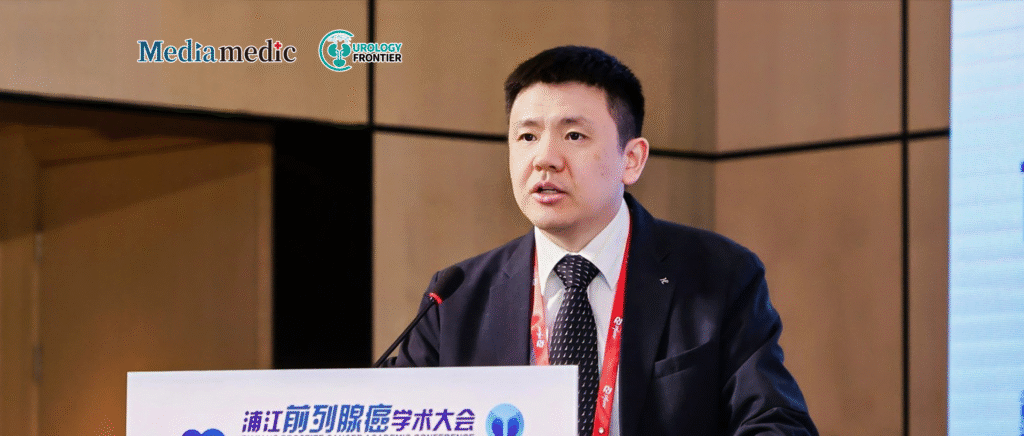
Editor’s Note: The 2025 Pujiang Prostate Cancer Academic Congress was held from June 27–28 in Shanghai, alongside the Annual Meeting of the CSCO Prostate Cancer Committee (CSCO-PC), the Prostate Cancer Conference of the CACA Genitourinary Oncology Committee (CACA-GO), and the Chinese Prostate Cancer Consortium (CPCC) Annual Meeting. With the theme “Global Wisdom, Chinese Practice, Precision Breakthroughs,” the event gathered international experts to exchange the latest clinical advances in prostate cancer. In an exclusive interview with Oncology Frontier – Urology Frontier, Professor Bo Dai of Fudan University Shanghai Cancer Center discussed the promising future of prostate-specific membrane antigen (PSMA)-targeted radioligand therapy in prostate cancer care.01
Oncology Frontier – Urology Frontier: Could you share the current clinical application and research progress of PSMA-targeted radioligand therapy in prostate cancer?
Professor Bo Dai: PSMA-targeted radioligand therapy has emerged in recent years as a novel and highly effective treatment for advanced prostate cancer. One of the most studied agents is ¹⁷⁷Lu-PSMA-617, a compound that links the radioactive isotope Lutetium-177 with the chelator DOTA through a linker. This construct specifically binds to PSMA, which is highly expressed on the surface of prostate cancer cells, enabling targeted radiation delivery and precise tumor cell killing.
PSMA is expressed in approximately 80% of prostate cancers, regardless of whether the disease is hormone-sensitive or castration-resistant. Therefore, ¹⁷⁷Lu-PSMA-617 holds therapeutic potential for the majority of patients with metastatic prostate cancer. Major clinical trials such as VISION and PSMAfore have confirmed its efficacy and manageable safety profile in metastatic castration-resistant prostate cancer (mCRPC), and the therapy has already been approved in the U.S. and Europe.
02
Oncology Frontier – Urology Frontier: Based on findings from the VISION and PSMAfore trials, how does PSMA-targeted radioligand therapy improve survival outcomes in prostate cancer? What advantages does it offer compared to traditional treatments such as chemotherapy or hormonal therapy?
Professor Bo Dai: Radioligand therapy targeting PSMA has demonstrated significant improvements in both radiographic progression-free survival (rPFS) and overall survival (OS) across multiple phase III randomized trials for patients with mCRPC.
The VISION study focused on patients who had previously received second-generation antiandrogens and 1–2 lines of chemotherapy. It showed that rPFS improved from 3.4 months (in the standard treatment group) to 8.7 months with ¹⁷⁷Lu-PSMA-617. OS also increased from 11.3 to 15.3 months. Notably, many patients in the control group received other active treatments—including alternative antiandrogens, bisphosphonates, and even radiopharmaceuticals—yet ¹⁷⁷Lu-PSMA-617 still outperformed standard care.
The PSMAfore study moved this therapy earlier in the treatment sequence. In patients who had only failed one second-generation antiandrogen and had not yet received chemotherapy, ¹⁷⁷Lu-PSMA-617 extended rPFS to 12.02 months, compared to 5.59 months in those switched to another antiandrogen. This demonstrated the benefit of introducing PSMA-targeted therapy earlier in the disease course.
Compared to traditional therapies, PSMA radioligand therapy offers several advantages:
- Superior efficacy: Clinical trials across different treatment lines have consistently shown significant rPFS gains.
- Broader applicability: Because of high PSMA expression in most mCRPC patients, a large proportion can benefit from this approach. In contrast, the effectiveness of later-line hormonal therapies is often limited, and PARP inhibitors are restricted to patients with specific genetic alterations.
- Favorable safety profile: Adverse effects are generally manageable, and treatment is well tolerated by patients, without markedly increased toxicity.
As a result, PSMA radioligand therapy is rapidly becoming an important treatment option for mCRPC, with the potential to reshape the therapeutic landscape.
03
Oncology Frontier – Urology Frontier: What do you see as the most important directions for the future development of PSMA radioligand therapy in prostate cancer?
Professor Bo Dai: The future of PSMA-targeted radioligand therapy is highly promising and will likely expand in several key directions:
- Earlier use in treatment lines: Clinical trials are already investigating its application in metastatic hormone-sensitive prostate cancer (mHSPC), oligometastatic disease, and even biochemical recurrence after surgery. These efforts aim to move this effective treatment into earlier stages of the disease.
- Combination strategies: Preliminary results from the ENZA-p trial suggest that combining ¹⁷⁷Lu-PSMA-617 with second-generation antiandrogens like enzalutamide may further extend progression-free survival and PSA response duration. Ongoing research is exploring whether combining ¹⁷⁷Lu-PSMA-617 with chemotherapy, PARP inhibitors, or other modalities can produce synergistic benefits greater than either treatment alone.
- Personalized approaches: As molecular profiling technologies advance, we anticipate more precise patient selection. Future treatment plans could be tailored based on PSMA expression levels, genomic mutations, and other biomarkers to optimize outcomes and minimize unnecessary toxicity.
In summary, PSMA radioligand therapy is poised to become a cornerstone in the evolving paradigm of prostate cancer care. Its ability to deliver effective, well-tolerated, and targeted treatment holds immense promise for improving patient outcomes and advancing precision oncology.



